
In situ, on-site, and grab, and automatic sampling
P.T. Weiss, A.J. Erickson, J.S. Gulliver, R.M. Hozalski, O. Mohseni, and W.R. Herb
Some pollutants can be measured in situ, on-site, or by analysis of grab or automatic samples. In situ, on-site, and grab sampling for assessment of stormwater treatment practices are cost-effective for some parameters that may be of interest. For example, capacity testing (level 2) of a stormwater treatment practice for hydraulic conductivity requires measurement of soil moisture content. Soil moisture can be measured either by using a field soil moisture probe (in situ sampling) or by collecting a soil sample and analyzing it in the laboratory (grab sampling). Another example includes synthetic runoff testing of a wet pond for hydraulic performance using a conservative tracer. Rather than using grab or automatic sampling, a conductivity probe could be used in situ to estimate salinity when sodium chloride (NaCl) is used as the conservative tracer. In this case, in situ sampling is simpler and cheaper than grab or automatic sampling, and therefore recommended.
In situ and on-site sampling for stormwater assessment are often limited by the availability of inexpensive probes for many pollutants of concern. In addition, in situ probes may become fouled when they are not maintained as recommended by the manufacturer’s instructions, which can produce erroneous measurements. It is also important to recognize changes that occur over time in the stormwater treatment practice system, such as sediment collection in an inlet pipe or structure, may affect in situ measurements. Some in situ probes such as pressure transducers or dissolved oxygen probes may require recalibration as conditions change. The following sections describe in situ, on-site, grab, and automatic sampling techniques as they apply to various stormwater pollutants.
Temperature
The temperature of stormwater runoff may be of interest depending on assessment goals and downstream conditions (e.g., temperature-sensitive trout streams). Unlike most water quality parameters, such as phosphorus or suspended solids, temperature can be easily measured with in situ or on-site techniques. One method is to collect a stormwater sample and measure the temperature on-site with a thermometer immediately after the sample is collected. Another method is to use a probe or sensor in situ to collect near-continuous temperature data with a data storage device. There are two types of data storage devices that are used for in situ temperature measurement: devices that are integrated into temperature probes and devices that are externally attached to them (often called data loggers). Temperature must be measured either in situ or on-site because water temperature can change during transportation or storage.
For near-continuous in situ sampling using a data storage device, the probe or thermocouple must be submerged during a runoff event. The device will continually measure and record temperature at a user-specified time interval until the data storage capacity is exhausted. Most devices can be set such that the oldest data are overwritten with new data when storage capacity is exceeded. For data storage devices that are integrated with the probe, data are usually downloaded directly to a computer through a data-transfer cable or infrared connection. An example of a data storage device integrated with a temperature probe manufactured by Onset is shown in Figure 5.2. For data storage devices connected to an external thermocouple, data are typically accessible via modem, cellular connection, or direct download (via serial cable) from the data storage device. An example of a thermocouple that would be externally connected to a data logger is shown in Figure 5.3.
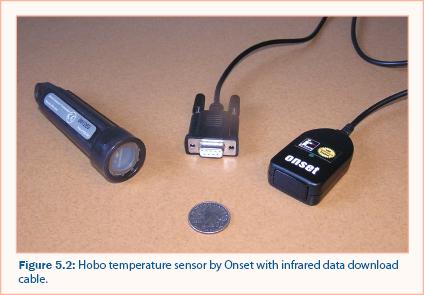
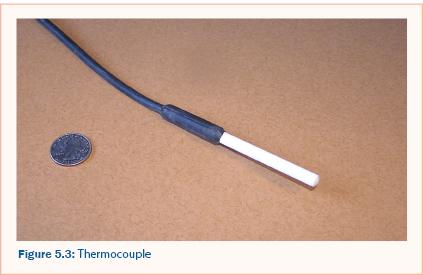
Some advantages of integrated and external data storage devices are listed below:
Integrated data storage device advantages
- Less expensive than data logger and thermocouple
- Data can be downloaded using infrared wireless connection
- Does not require protective cabinet to store data storage equipment
External data storage device advantages
- Less expensive if a data logger is already in use
- Temporally synchronized with other measurements stored in the data logger (e.g., discharge, rainfall)
- Typically more storage capacity than an integrated device
- Thermocouples respond more quickly to temperature changes
- Data retrieval does not require disturbance of the thermocouple
- Data can be downloaded via modem or cellular connection
The U.S. EPA (U.S. EPA. 2002) notes that some pressure transducers have built-in thermometers so that water depth values can be corrected for temperature. Manufacturers of such temperature probes (at the time this manual was written) include: Campbell Scientific, Inc.; Onset; and Vemco. Probes are available for different temperature ranges, depths, and prices.
A simple procedure for developing an assessment program for thermal assessment, including installation guidance and calculation of results, is provided in Assessing thermal impacts.
pH or hydrogen ions
The acidity or basicity of water is indicated by pH, which is a function of the molar concentration of hydrogen ions in solution ([H+]), pH = -log10[H+]. Thus, for a water of pH 8, the hydrogen ion concentration is 10-8 moles/L. Acidic waters have relatively large hydrogen ion concentrations and therefore small pH values (< 7). Alkaline waters have relatively small hydrogen ion concentrations and large pH values (> 7) and neutral waters have pH values of approximately 7. Federal and state regulations suggest that pH values remain between approximately 6.5 and 8.5 to ensure the quality of water for recreational use, aquatic life, and drinking water (MPCA 2003, U.S. EPA 2004).
In situ or on-site sampling should be used to measure pH values. Probes are available from several manufacturers for in situ or on-site measurement. Grab samples for pH with subsequent analysis in a laboratory are permissible if the samples are transported on ice and analyzed within two hours of collection; automatic sampling for pH measurement is not recommended. Probes should be calibrated weekly, after every 25 samples (U.S. EPA 1997), or as recommended by the manufacturer to ensure accurate and consistent results.
Conductivity
Conductivity is an indirect measure of the ion concentration in water and is often measured with a probe or meter using in situ or on-site sampling techniques. Conductivity is often used as a surrogate for total dissolved solids (TDS) or salinity. Large concentrations of TDS can be toxic to aquatic life and can reduce habitat.
Conductivity is most often measured in situ or on-site but can also be measured using grab or automatic sampling techniques. Most ‘bundled’ probes (multiple probes in one device) include a conductivity probe for in situ sampling. An example of a Hydrolab bundle probe is shown in Figure 5.4. Grab or automatic samples transported to an analytical lab for conductivity measurements must be analyzed within 28 days of collection and should be kept on ice or refrigerated.
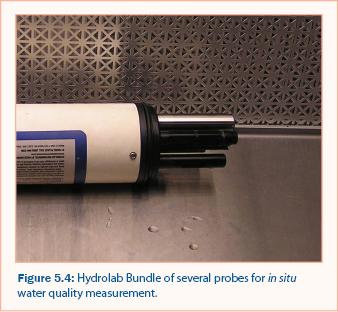
Turbidity
Turbidity is a measure of water clarity and can be measured in situ with a turbidity meter. Large turbidity values can block sunlight required for photosynthesis by aquatic vegetation and subsequently reduce aquatic life and diversity. Turbidity can be used as a surrogate for suspended solids concentration but requires calibration at each location and for different seasons to ensure accuracy (Stefan et al. 1983). Refer to the turbidity section in Standard Methods (e.g., A.P.H.A. 1998b) for details about correlating turbidity and suspended solids.
Turbidity is most often measured in situ or on-site, but samples collected manually (i.e., grab) or by automatic samplers can also be transported to an analytical lab for analysis. Some ‘bundled’ probes include a turbidity meter. Grab or automatic samples transported to an analytical lab for turbidity measurements must be analyzed within 24 hours of collection and should be kept in the dark and on ice or refrigerated.
Dissolved oxygen
Dissolved oxygen (DO) is the amount of oxygen dissolved in water. DO is necessary for the survival of aerobic aquatic organisms such as fish and invertebrates. Minimum dissolved oxygen concentrations in Minnesota are 7 mg/L for Class 2A waters (aquatic life and recreation), and 5mg/L for Class 2B and 2C waters (MPCA 2003); in Wisconsin, 6 mg/L for Coldwater A & B waters and 5 mg/L for Diverse Fish and Aquatic Life (WDNR 2004); in Michigan, 7 mg/L in all Great Lakes, connecting waterways, and portions of stratified lakes and never less than 5 mg/L (MDEQ 2006).
DO should be measured using in situ or on-site sampling techniques. Grab and automatic sampling for DO measurement is not recommended because DO concentrations can change during transport or storage. For on-site sampling, DO should be measured immediately after sample collection. Most DO probes require weekly cleaning and re-calibration to ensure accuracy. Luminescent DO measurement techniques are available, but their accuracy and stability has not been thoroughly field- tested.
Nutrients
Nutrients (e.g., phosphorus and nitrogen) support aquatic vegetation and organisms. Excess nutrients, however, can cause nuisance algae blooms that generate negative aesthetic and eutrophic conditions in receiving lakes and rivers (U.S. EPA 1999). In temperate fresh waters, dissolved phosphorus is typically the limiting nutrient (Schindler 1977, Aldridge and Ganf 2003).
Until recently, it was necessary to collect water samples by automatic or grab sampling techniques for subsequent analysis in a laboratory to determine nutrient levels. In situ probes, however, are now available for nitrate, ammonia, and phosphate. Two examples of in situ nutrient probes are shown in figures 5.5 and 5.6. Nevertheless, the accuracy and stability of these probes has not been thoroughly demonstrated in the field.
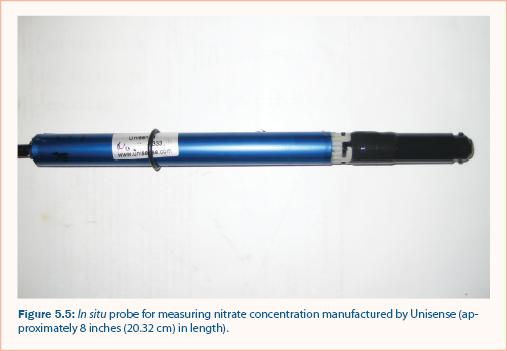
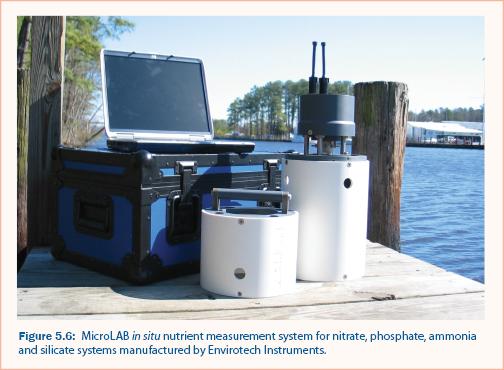
Continue to Additional considerations for automatic sampling.